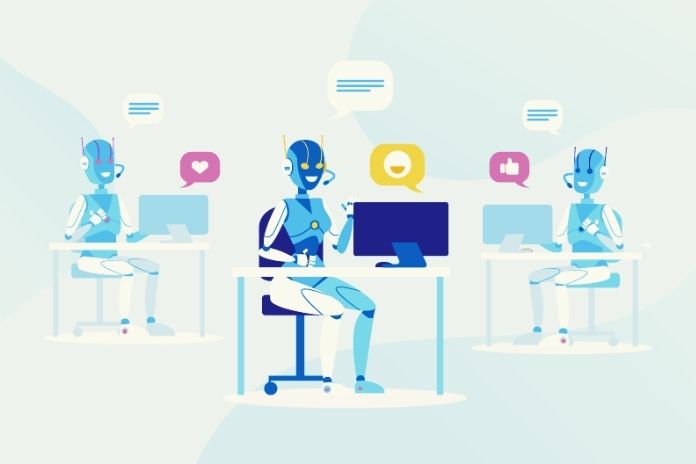Artificial intelligence and automation enable innovation. The digital transformation will also increasingly inspire customer service. Which technological and strategic trends you should be aware of.
In the face of the home office, digitization, and “new work,” companies and employees are rethinking how we work. These circumstances gave rise to what is known as the “gig work economy,” as it is known in the music industry. What is meant is that employees only work at a company for a limited period until they find something that better suits their personal preferences. It is also becoming increasingly difficult for customer service to find good employees. Often, new hires are in this space for the first time—and may not stay long-term. Technology can help to close the knowledge gaps created by this fluctuation.
Artificial intelligence, for example, is changing the work of service agents and enabling companies to offer autonomous service options. Employees can devote themselves to more complex problems that require active interaction with people, which leads to a better employee experience. The increased focus on the employee experience will pay off for companies, turning gig work into good work in customer service.
Customer Service: Voice AI Arrives In The Mainstream
A critical factor in improving the employee experience is voice AI technology. In recent years, companies and consumers alike have often viewed personal telephone service as an old-school analog channel – but that is over. Today’s service world reacts almost euphorically when it comes to optimizing language-based interactions. Voice AI, powered by real-time speech-to-text analysis, can act as an intelligent co-pilot for service agents and make their work more enjoyable. The artificial intelligence on which voice AI technology is based has learned a lot. She could hardly provide more than a transcript of a conversation in the recent past.
However, with new real-time call analysis capabilities, the AI can now enter data into the system and fill out forms without the service agent lifting a finger. The automatic display of further information, which the intelligent co-pilot derives from the context of the conversation, is now also possible. This results in better service for customers. Thanks to AI support, service agents can concentrate fully on the person on the other end of the line instead of on administrative tasks. An actual win-win situation.
Autonomous Service Replaces Self-Service In Customer Service
The pandemic has also impacted the customer side – those seeking help are increasingly making use of self-service offers. However, the more modern variant of self-service, the autonomous service, is more promising. However, with this approach, the focus is on the customer journey and where the customers are on their journey, no longer on individual products or services.
The driving force behind autonomous services is (real-time) AI, but intelligent automation and event and pattern recognition are also used. All service interactions – unlike self-service offerings – offer a consistent solution, no matter at which point in the customer journey the customer decides to engage in an exchange. It also makes no difference whether he is looking for personal contact via telephone customer service or whether it is an automated interaction, for example, via a chatbot. Autonomous services reduce service costs for companies, and customers can enjoy improved mean time to process (MTTR).
Customers Want Proactive And Preemptive Customer Service
The principle of autonomous service enables companies to offer far more of the previously standard reactive service: The times when the customer always had to turn to the service provider for help actively are over. Of course, in the event of problems, it is better if the benefit comes to the customer on its own. Many companies now believe they can proactively monitor customer data and alert customers to problems before they arise. In some cases, even state-of-the-art technology could enable companies to solve emerging issues before the customer even knows about them. This trend is forward-looking for the service industry. The number of outbound contacts with customers (proactive and preemptive) will exceed inbound communications within a few years.
Data Protection Takes Center Stage
After the massive changes during the pandemic, consumers and companies will again be more concerned with essential issues such as data protection. The areas of customer experience, marketing, and customer relationship management face significant challenges. Google, for example, has announced that it intends to phase out third-party cookies by 2023. Companies must, therefore, fundamentally rethink their marketing strategy. Laws such as the GDPR and similar initiatives in the USA (CCPA, CPRA, and ColoPA) are already in force or are planned. The compliance area is thus becoming more complicated, and companies must now examine how they can adapt their processes to guidelines and laws.
It Depends On The Exemplary Architecture
The past two years have taught those responsible in the service sector that standing still is no longer an option. A truly digital transformation of service strategy is the desire of many organizations to enable new scalability, efficiency, and effectiveness without the latency of historical “big bang” approaches. From a technical perspective, microservices and channel-agnostic strategies can help. Modern microservices architectures orchestrate the customer journey and the solution centrally and independently of the channel. In addition, these can be integrated into many existing systems.
This requires some organizations to modernize the service case management backbone across their operations while retaining the existing service desktop. Others may need to integrate new layers of AI and automation into existing channels. After all, companies can now also modernize voice dialog (IVR) and e-mail systems and align them with the customer journey without replacing them. The current developments pose enormous challenges for the service industry, that much is certain. But it is also a fact that modern technologies and sophisticated strategies offer companies the right opportunities to master these challenges. Golden times are dawning for both customers and employees in the industry.
ALSO READ: Multi-Cloud Strategy: From Hosting Provider To Hyper-Scale

